×
CONTACT US
CONTACT US
How do we share more ideas faster? – it’s undoubtedly the most uplifting way of framing the daunting technological challenges we face with 5G. How do we transport vast amounts of data around the globe almost instantly? How do we enable colleagues to effortlessly communicate in real-time across corporate campuses, countries, and continents?
E band mmWaves (millimeter wave) have the potential to deliver the ultra-high capacity low latency needed for countless connectivity applications including:
From private to public sector, civilian to military, and everything in between - the opportunities are almost endless. Before we can fully realize that potential, we must tackle the titanic infrastructure challenges of transporting all that data.
Wireless transport engineers have been hard at work testing multiple technologies tasked with transporting this unprecedented amount of information. some leading contenders include massive MIMO, beamforming, full duplex, high-density small base stations, and millimeter waves (mmWave).
Millimeter wave unlocks extreme capacity, ultra-high throughput, and does it all with remarkably low latency. Those attributes paired with fast and affordable deployment make it the favorite option of many network operators.
Millimeter wave technology (mmWaves) goes by several different names. You may have heard it referred to as millimeter band, high band 5G, or Extremely High Frequency (EHF) band by the International Telecommunication Union (ITU). Regardless, all the names refer to a line-of-sight wireless communication technology that typically uses the portion of the spectrum with wavelengths between 4.2 millimeters (71 GHz) and 3.4 millimeters (86 GHz) to wirelessly transmit and receive high-frequency beams of radio waves carrying voice, video, and data information.
Millimeter waves deliver many benefits relative to traditional microwave and other legacy technology including an enormous availability of frequency bands above 24 GHz.

All-Bands Spectrum
When comparing the time, cost, and complexity of deploying new cell sites, mmWave links have an obvious advantage over fiber, especially in densely populated urban centers. New mmWave links can be up, and operational within a few hours. Conversely, securing permits to dig and lay fiber in a busy city could take weeks or even months and incur substantial CAPEX.
Cell sites utilizing millimeter wave can use smaller integrated flat panel antenna technology and auxiliary equipment that in turn, require less energy to power and a fraction of the real-estate footprint to house, operate, and maintain. That results in less initial CAPEX and less recurring OPEX. mmWave links also provide incomparable flexibility, as network traffic evolves links can easily be relocated. If you’re looking for a deep dive covering all of the ins and outs of E-Band Millimeter Wave for the Telecom Market check out Ceragon’s White Paper below.
mmWave links also provide incomparable flexibility, as network traffic evolves links can easily be relocated. If you’re looking for a deep dive covering all of the ins and outs of E-Band Millimeter Wave for the Telecom Market checkout Ceragon’s White Paper below.
While millimeter waves promise enormous potential in terms of capacity increases and latency decreases for wireless telecommunications there are some current limitations that need to be considered. Due to their high frequency and short wavelength, mmWave signals have difficulty traveling more than a few hundred meters in open spaces and have the potential to be absorbed by obstacles such as buildings, trees, and even raindrops.
To overcome this limitation, researchers and engineers have been working on a variety of new long-reach technologies that can expand the distance that mmWave can be utilized for wireless telecommunications. Several vendors are releasing high-power variants of existing carrier models. In addition, external power boosters can be added to provide up to 9dB of gain.
Adding a larger 3-foot stabilized antenna is another method to increase millimeter wave reach. The Stabilized Beam Antenna method or SBA provides dual axis stabilization reducing the Received Signal Level (RSL) variations from approximately 20dB to 2.5dB.
Combining power boosters that amplify gain along with larger stabilized antenna can double the reach of millimeter wave from 2.5km to 5km, adding multiband technology can take millimeter wave even further, all the way up to 15km and beyond.
Overall, the distance limitations of mmWave signals are being addressed through a combination of new technologies. These developments are expected to have a significant impact on the future of 5G networks and wireless communications, enabling new mmWave use cases and applications that were previously impossible, while also reducing costs and improving network efficiency for wireless network providers.
Multiband technology works by combining multiple frequency bands to achieve wider coverage and higher data rates. In 5G networks, this is typically done by combining the low-band (sub-1 GHz), mid-band (1-6 GHz), and high-band (mmWave) frequencies to provide a balance between coverage, capacity, and speed.
Microwave frequencies are used for wide-area coverage and penetration through obstacles, while millimeter wave frequencies are used for ultra-high-speed data transmission.
By combining these frequency bands, 5G networks can achieve optimal coverage and performance, while also overcoming the current limitations of mmWave.
For example, wireless network providers can use:
|
Moreover, multiband technology can also save on tower load and leasing costs by allowing multiple frequency bands to be transmitted from a single antenna. This means that wireless network providers can maximize the use of their existing infrastructure and minimize the need for additional towers and antennas. In addition, some vendors sell dual core and multicore radios that can combine multiple carriers on a single antenna, allowing for even more efficient use of the available frequency spectrum. This further enhances the performance and efficiency of wireless networks and makes multiband technology an essential component of modern telecommunications. |
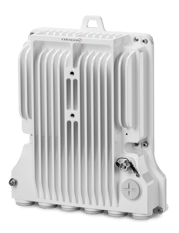 |
Multiband technology is an important innovation that enables wireless network providers to achieve optimal coverage and performance, particularly in the context of mmWave in 5G networks. By combining different frequency bands and using advanced technologies such as dual-core microwave radios, wireless network providers can deliver high-speed, low-latency connectivity to a wide range of users and applications. Before you dive into multiband deployment check out our video checklist
Choosing the right fronthaul solution for your network requires carefully weighing the pros and cons of available options against the needs of your existing infrastructure, budget, and timeline for expansion, along with a myriad of other factors. If you’re looking for a thorough refresher on the basics of fronthaul look no further than Ceragon’s Fronthaul 101.
In essence, fronthaul solutions are the links between the baseband unit (BBU) and remote radio heads (RRHs) in a wireless network. The fronthaul solution you choose plays a crucial role in delivering high-quality mobile services. When selecting a solution, you’ll need to determine if centralized or decentralized RAN architectures are right for your application.
Centralized RAN (C-RAN) architecture provides many benefits, including improved resource utilization and network flexibility, as well as lower operating costs. C-RAN solutions use a centralized BBU pool, which is responsible for baseband processing for multiple RRHs.
This architecture allows for efficient resource allocation and dynamic bandwidth allocation, reducing the amount of redundant hardware required for network deployment. As a result, C-RAN offers a cost-effective, scalable, and flexible solution for fronthaul.
Decentralized RAN (D-RAN) architecture, on the other hand, offers many benefits, including:
D-RAN solutions deploy the BBU and RRHs separately, which provides better coverage and capacity than C-RAN solutions. This architecture allows for the deployment of smaller cells that can be located closer to users, resulting in lower latency and improved user experience. D-RAN is an ideal fronthaul solution for areas with high traffic density and where low latency is critical.
Selecting the right fronthaul solution will help to ensure efficient network deployment, improved user experience, and reduced operating costs.
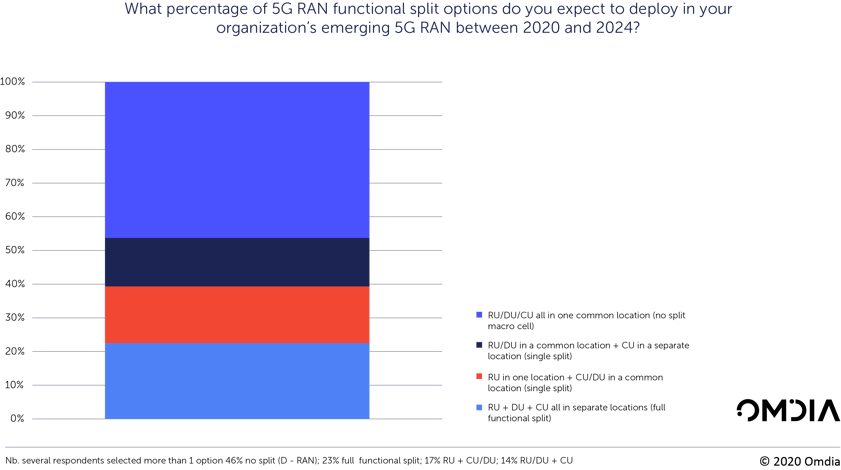
The demand for E-band continues to grow due to the growing need for ultra-high capacity low-latency connectivity and the move toward disaggregated network architectures.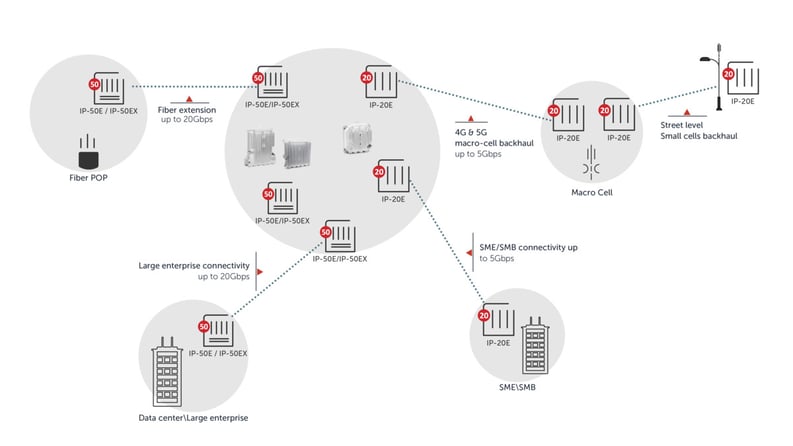
Here are four common use cases that are well served by the E-band millimeter wave (mmWave) range of frequencie
To meet growing coverage and capacity requirements, the successful deployment of 5G often necessitates the smart combination of fiber and wireless technologies, especially as the reach of fiber is often limited by cost or infrastructure considerations.
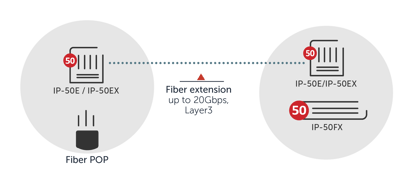 |
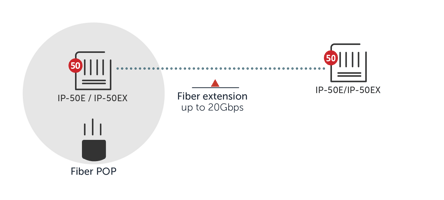 |
In this fiber extension use case, a mobile network operator (MNO) uses E-band mmWave for fiber point of presence (POP) connectivity.
In cases of “last mile” connectivity over a typical 1-2 kilometers, E-band mmWave is a good choice as it can deliver the 10-20 Gbps usually required for such a use case and can do so with high reliability. When longer links are required, E-band mmWave can be combined with traditional microwave in a multiband configuration.
In this large enterprise connectivity use case, an internet service provider (ISP) offers a high-capacity fixed wireless service that connects a large corporation. Such connectivity often includes links between multiple large company buildings within a spread-out organizational campus or across busy city streets.
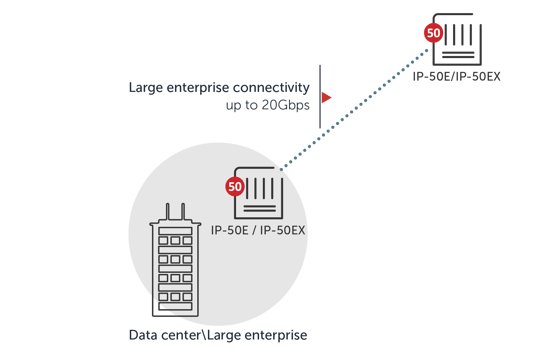
In such cases, E-band mmWave can deliver 99.999% (five-nine) availability over links of up to 1-2 km, or four-nine availability for links up to 2-3 km.
Large enterprise connectivity usually requires somewhere around 4-10 Gbps, while intra-campus connectivity calls for 2-5 Gbps. In these cases, 10 Gbps is usually more than sufficient.
There are also similar use cases involving ISPs connecting smaller enterprises/businesses (SMEs/SMBs) and smaller campuses.
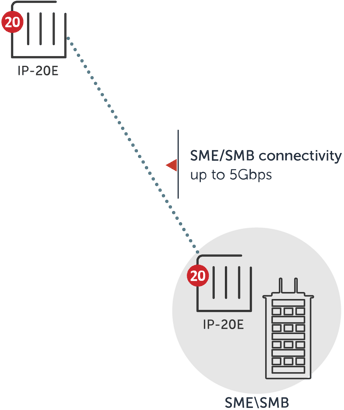
In terms of reach, like with the previous large enterprise use case, E-band mmWave supports five-nine availability over links of 1-2 km. These use cases typically require up to 2.5 or 5.0 Gbps.
In the 5G/4G macrocell and small cell backhaul use case, an MNO uses E-band mmWave to connect street-level small cells to a macrocell, which in turn connects to the aggregation site towards the core network.
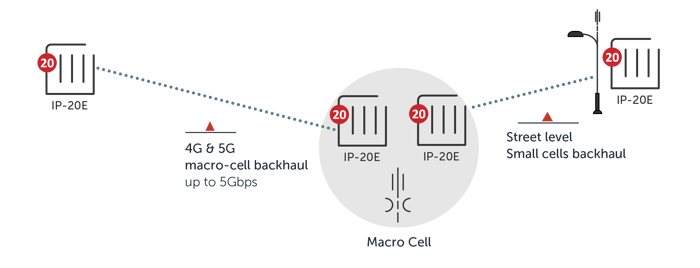
At the street level, there is a need for a simple and cost-effective all-outdoor solution with an integrated antenna, with an appearance similar to a Wi-Fi hotspot. Deployed in a “mesh-like” configuration, small cell links range from a few hundred meters up to 1 km.
Typically, a capacity of 2.5 Gbps is sufficient for small cell backhaul, with up to 5 Gbps needed for aggregation points.
Copyright © Ceragon | Terms & Conditions | Privacy Policy